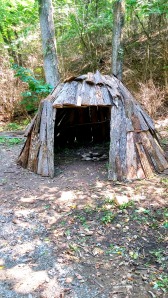The Native American wigwam was the primary choice of home for Northeastern Indian peoples. The word wigwam derives from the Algonquin root word wig- which means “to dwell.” These homes were mainly structured to house one family, but if it was necessary then they would have to make room for a second family to live.
Wigwams are often mistaken for the traditional Indian teepees due to their conical shape, but these styles of homes could not be any more different. Wigwams were not subject to a conical shape there were also round shaped and a-framed wigwams depending on the reason for their use. The three different types of Northeastern wigwams were permanent small homes, seasonal small homes, and camp shelters.
The primary small homes were used for a more solidified time frame, usually year-round. Since these wigwams had to be more stable, they were covered with heavier barks like elm, ash, hickory, and poplar. The interiors had to be insulated to keep in the warmth, so the women would make mats to keep on the inside of the wigwams.
Seasonal wigwams were only to be used for a few short months, around the duration of an entire season. Many of the native communities used these to get through the winter seasons and would use them as multi-family homes called longhouses. They didn’t last very long so they were comprised of lighter barks like birch. These seasonal frames were primarily rounded.
Camp shelters were only used temporarily, from a few days to a few weeks. They would be used recreationally, so similar to our idea of camping today. Usually conical in frame, camp shelters would be open-structured or slightly insulated from the elements depending on the season.
The wigwam we have here at the Village is a conical-styled primary small home. Come check it out during our Fall Harvest Festival on September 20th, 10am-5pm, and September 21st 12pm-5pm. Admission is $8.00 for adults and $4.00 for children 5-11. Children 4 and under and Museum members are FREE. See you there!
Sources:
“The Native American Wigwam.” HubPages. Ed. WoodlandIndianEdu. N.p., n.d. Web. 17 Sept. 2014. http://woodlandindianedu.hubpages.com/hub/the-native-american-wigwam
